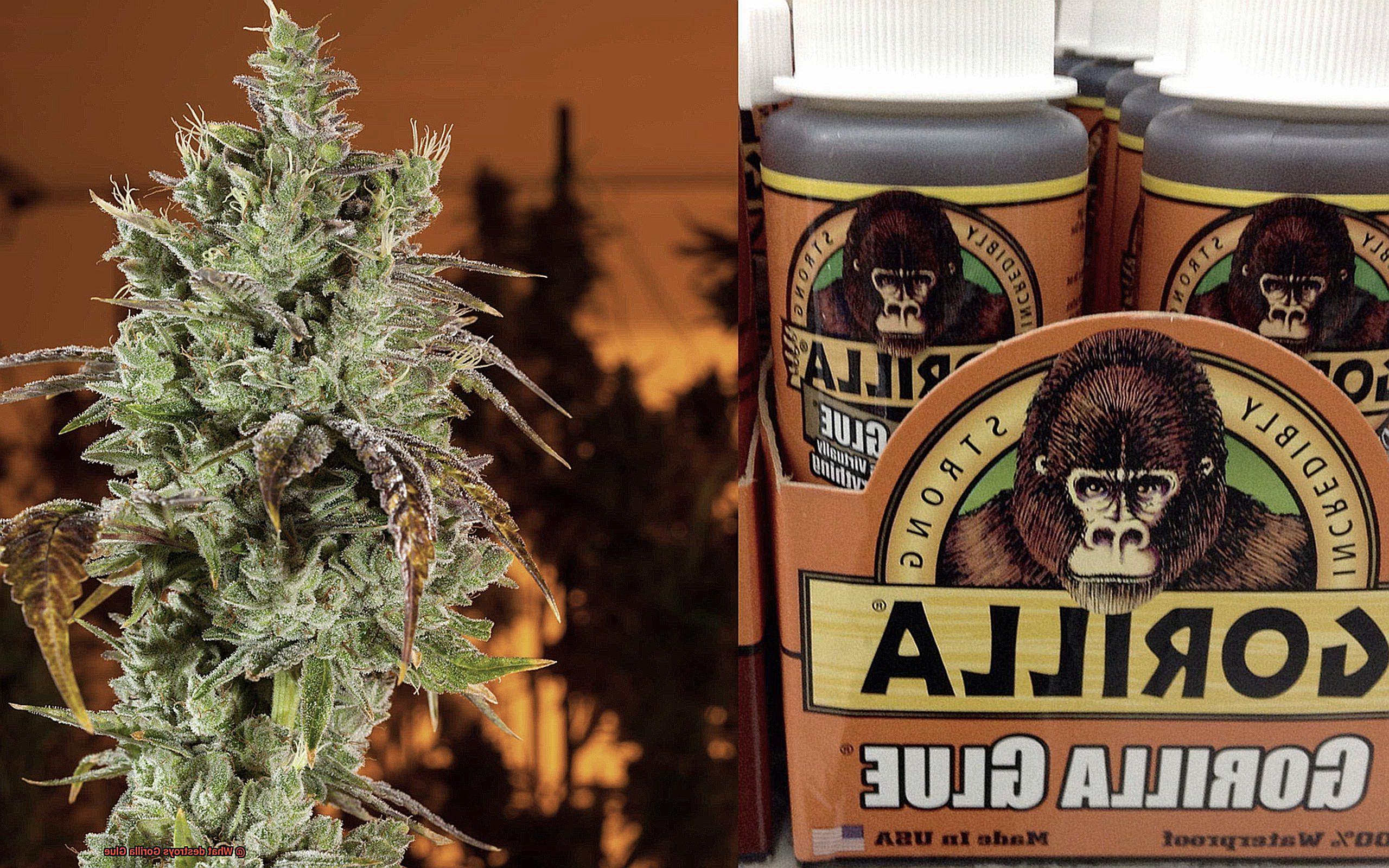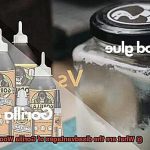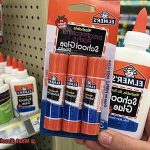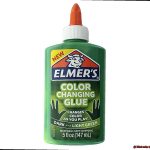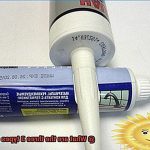Have you ever found yourself in a sticky situation, trying to remove Gorilla Glue from surfaces? It can feel like an endless battle, with the stubborn adhesive refusing to budge no matter how hard you scrub and scrape. But fear not, my fellow glue warriors, because I’m here to share some top-secret tips on what destroys Gorilla Glue.
As an expert on the topic, let me tell you that Gorilla Glue is no ordinary adhesive. Made from polyurethane, it’s renowned for its exceptional bonding strength. But this also means that it can be a real pain to remove once it’s dried and cured. So what’s the solution?
Enter acetone – the hero of nail polish remover. This magic liquid can dissolve the glue and make it easier to remove from surfaces. And if that doesn’t work, try applying heat with a hairdryer or heat gun. The warmth softens the glue and makes it easier to scrape away.
But wait, there’s more. These are just a couple of effective ways on what destroys Gorilla Glue. Keep reading for more tips and tricks on how to deal with stubborn adhesives like a pro.
So don’t let Gorilla Glue get the best of you – armed with these techniques, you’ll be able to bid adieu to pesky residue in no time.
What is Gorilla Glue?
Contents
- 1 What is Gorilla Glue?
- 2 Why Do We Need to Destroy Gorilla Glue?
- 3 How to Destroy Gorilla Glue Using Acetone
- 3.1 Step 1: Ensure Proper Ventilation
- 3.2 Step 2: Gather Materials
- 3.3 Step 3: Protect Yourself
- 3.4 Step 4: Apply the Acetone
- 3.5 Step 5: Wait for It
- 3.6 Step 6: Scrape Away the Glue
- 3.7 It’s important to note that acetone can also damage certain surfaces such as plastic or painted surfaces, so make sure to test a small, inconspicuous area before attempting to remove Gorilla Glue with acetone.
- 4 How to Destroy Gorilla Glue Using Heat
- 5 Other Methods of Destroying Gorilla Glue
- 6 Pros and Cons of Different Methods
- 7 Tips for Safely Removing Gorilla Glue
- 8 Common Pitfalls When Removing Gorilla Glue
- 9 Conclusion
Gorilla Glue is the household name for polyurethane adhesives and is known for its incredible strength and versatility. Its creation can be credited to the Gorilla Glue Company, based in Cincinnati, Ohio. While the company produces several different types of adhesives, Gorilla Glue is their most well-known product.
What is Gorilla Glue?
Gorilla Glue is a moisture-curing adhesive, which means that it requires water to activate and cure properly. When it comes into contact with moisture, it expands and forms a robust bond between two surfaces. This makes it an ideal adhesive for a variety of applications, including woodworking, metalworking, and construction.
What are the unique features of Gorilla Glue?
One of the key features of Gorilla Glue is its ability to bond to a wide range of materials like wood, metal, ceramic, stone, and foam. This adhesive can even be used to bond dissimilar materials together such as metal to plastic or wood to glass.
This versatility has made it a popular choice among DIYers and professionals alike.
However, Gorilla Glue isn’t recommended for use on certain materials like polyethylene or polypropylene plastics as it may not work effectively.
Additionally, it can be difficult to remove once it has cured, so it’s important to use it carefully and follow the manufacturer’s instructions.

How does one remove Gorilla Glue?
While Gorilla Glue is notoriously difficult to remove once it has cured, there are a few methods that can be effective in breaking down the adhesive. One common method is to use acetone, which can break down the chemical bonds in Gorilla Glue.
Another option is to use heat, which can cause the glue to soften and break down.
Other methods that have been known to effectively destroy Gorilla Glue include using rubbing alcohol, vinegar, or a mixture of baking soda and water.
Why Do We Need to Destroy Gorilla Glue?
Gorilla Glue is a remarkable adhesive that can bond almost anything together. Its strength and versatility have made it a favorite among DIYers and professionals alike. However, there are times when you may need to destroy Gorilla Glue, and this is where things get tricky.
So, why do we need to destroy Gorilla Glue? Let’s dive into the reasons why it’s necessary.
- Incorrect Application: Gorilla Glue is known for its powerful bonding properties, and once it sets, it’s not coming off without a fight. If you’ve applied the glue incorrectly or accidentally stuck it to the wrong surface, removing it can be a real pain. Destroying the glue becomes a necessity to avoid damaging the surface or ruining your project.
- Expiration: Like any other product, Gorilla Glue has a shelf life. Using expired glue can lead to poor results, making it essential to dispose of it safely by destroying it. This will ensure that you don’t run into any mishaps and get the best results from your project.
- Safety Concerns: Safety is always a significant concern when it comes to using any adhesive product, and Gorilla Glue is no exception. The adhesive can expand and foam when exposed to moisture, making it extremely difficult to remove from surfaces. This can be dangerous if the glue gets onto your skin or eyes. In such situations, destroying the glue becomes a priority to prevent any accidents or injuries.
- Proper Disposal: It’s crucial to follow proper disposal procedures when destroying Gorilla Glue. The glue should never be thrown in the trash as it can cause harm to the environment. Instead, one should consider recycling or disposing of the glue at a hazardous waste facility.
How to Destroy Gorilla Glue Using Acetone
Gorilla Glue is a powerful adhesive that can be difficult to remove, but with the help of acetone, you can easily destroy it. However, it’s important to take proper precautions and follow specific steps to ensure success.
Step 1: Ensure Proper Ventilation
Before starting the process, make sure to work in a well-ventilated area. Acetone can be harmful if inhaled, so it’s important to protect yourself and those around you.
Step 2: Gather Materials
You’ll need a few materials to get started, including gloves, a clean cloth or paper towel, and a bottle of pure acetone.
Step 3: Protect Yourself
Put on your gloves to protect your skin from the acetone.
Step 4: Apply the Acetone
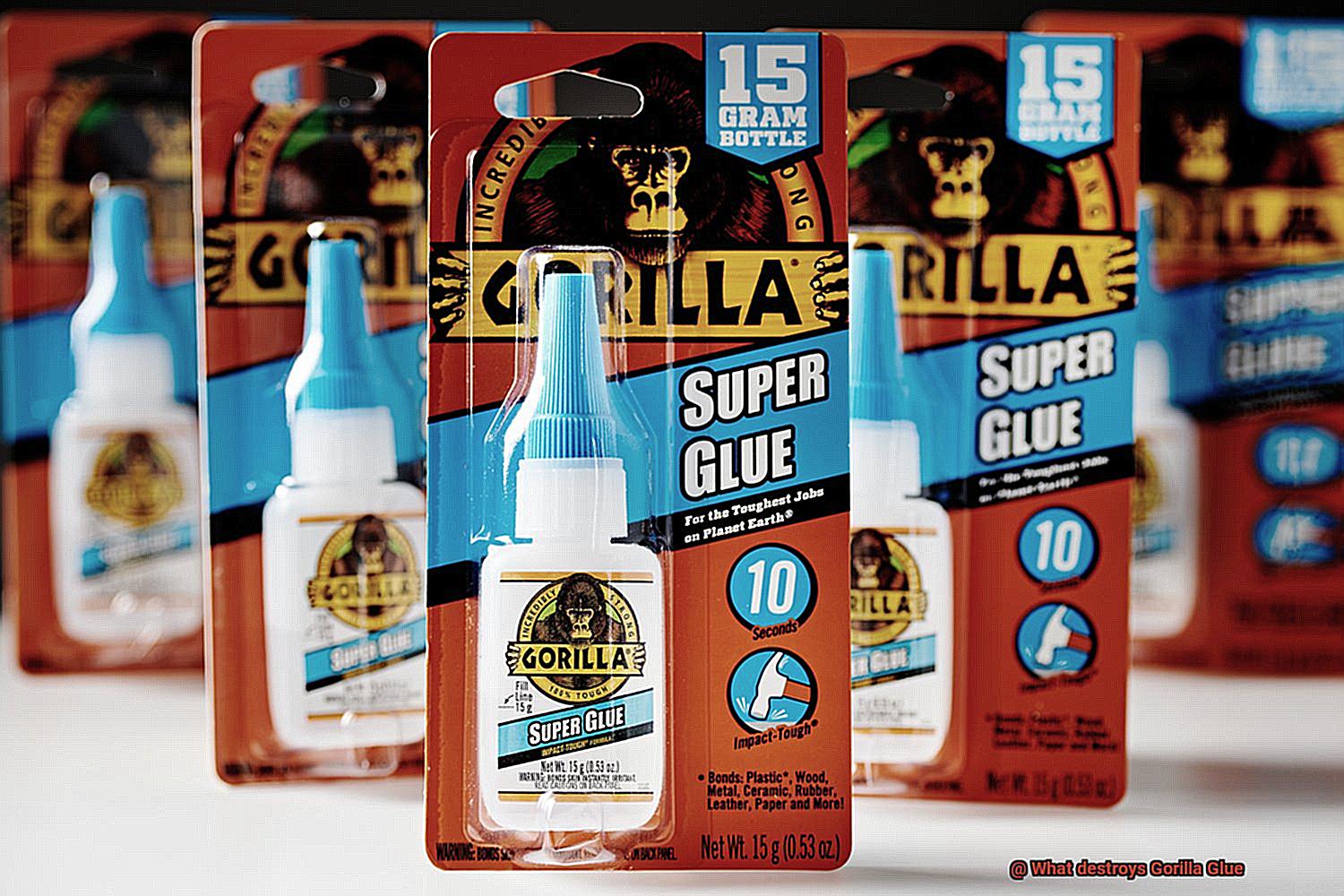
Soak the cloth or paper towel in the acetone and press it onto the Gorilla Glue. Ensure that the glue is completely covered with the acetone-soaked cloth or paper towel.
Step 5: Wait for It
Be patient and wait for about 15-20 minutes. During this time, the Gorilla Glue should start to soften and become easier to remove.
Step 6: Scrape Away the Glue
Use a scraper or dull knife to gently scrape away the glue. If the glue is still too hard, repeat the process until it softens enough to be removed.

It’s important to note that acetone can also damage certain surfaces such as plastic or painted surfaces, so make sure to test a small, inconspicuous area before attempting to remove Gorilla Glue with acetone.
In addition, always follow proper safety precautions when working with chemicals such as acetone. Wear gloves and work in a well-ventilated area to avoid inhaling fumes.

How to Destroy Gorilla Glue Using Heat
Gorilla Glue is a popular adhesive used in DIY projects for its strength and durability. However, there may come a time when you need to remove or destroy the glue, and heat is one of the most effective methods. In this guide, we will explain how to safely use heat to destroy Gorilla Glue.
Why Heat is Effective

Gorilla Glue is a thermosetting adhesive that hardens and cures when exposed to heat. Therefore, applying heat can break down its chemical structure and weaken its bond. Heat can be applied using a heat gun, hair dryer, or even an oven.
How to Apply Heat
When using a heat source like a hair dryer or heat gun, direct the hot air onto the glued area in a sweeping motion. Avoid holding the heat source in one spot for too long to prevent damage to the surface.
If using an oven, preheat it to 180-200 degrees Fahrenheit and place the item with the Gorilla Glue in the oven for 10-15 minutes.
Monitor the item closely to avoid overheating or causing damage.
Removing Softened Glue
As you apply heat, you may notice the glue start to bubble or soften. This is a good sign. Use a scraper or plastic spatula to gently pry away the softened glue, taking care not to scrape too hard and damage the surface.
Considerations for Using Heat
Using heat may not be effective in all cases. If the glue has fully cured or is on a porous surface, it may be more difficult to remove. In these instances, it may be necessary to use other methods such as solvents or sanding.
It’s also important to exercise caution when using heat, as high temperatures can pose a fire hazard and potentially damage the bonded surfaces.
Other Methods of Destroying Gorilla Glue
So, you’ve found yourself in a sticky situation with Gorilla Glue, but don’t worry, there are still a few other tricks up your sleeve.
If you’ve already exhausted heat and solvent removal methods, here are some alternative approaches to consider:
First up, we have the trusty sandpaper method. This involves physically wearing down the glue’s bond using an abrasive material like sandpaper or a rough sponge. While it may take some elbow grease and patience, this method can be effective on some surfaces.
If you’re feeling a bit more adventurous, you can try using mechanical force to break apart the bond. This involves using tools like a hammer and chisel to pry apart the glued objects. However, be warned that excessive force could cause damage to the objects being separated, so proceed with caution.
Another option is to expose the glue to moisture. This works particularly well if the glue hasn’t fully cured yet. Simply apply a damp cloth or paper towel to the glued area and let it sit for several hours. The glue may become more pliable and easier to remove.
However, it’s important to note that while these alternative methods can be effective, they should only be attempted with caution and in accordance with safety guidelines. Gorilla Glue is known for its strength and durability, so removing it requires careful consideration of the materials involved.
In addition, following the manufacturer’s instructions is always recommended for removing Gorilla Glue or seeking professional assistance if necessary. It’s better to be safe than sorry when it comes to handling such powerful adhesives.
Pros and Cons of Different Methods
Gorilla Glue is a popular adhesive that boasts its strength and durability. However, situations may arise where you need to remove or destroy the glue. Fortunately, there are different methods for destroying Gorilla Glue, each with their own set of pros and cons.
One method for destroying Gorilla Glue is to apply heat. Heat can soften the glue, making it easier to remove. You can use a heat gun or a hairdryer to apply heat. The advantage of using heat is that it’s a quick method that doesn’t require any harsh chemicals. However, caution must be taken since excessive heat can damage the surface that the glue is bonding to.
Another option is to use solvents. Solvents can dissolve the glue and make it easier to remove. Common solvents include acetone, rubbing alcohol, and mineral spirits. The major benefit of using solvents is that they’re effective and don’t require any physical force. However, some solvents can damage certain surfaces, so it’s important to test them in an inconspicuous area before using them on the entire surface.
Mechanical methods such as scraping or sanding can also be employed to remove Gorilla Glue. These methods require physical force but can be effective. Nevertheless, they also have the potential to damage the surface or leave marks.
Lastly, there are natural methods that people recommend for destroying Gorilla Glue. Vinegar or lemon juice are often suggested as natural solvents. The beauty of these methods is that they’re non-toxic and don’t require any special equipment. However, they may take longer and may not be as effective as other methods.
Tips for Safely Removing Gorilla Glue
We’ve got you covered with these tips for safely removing it from different surfaces. Gorilla Glue is a strong adhesive that can bond almost anything together, but accidents happen, and sometimes it can end up where it shouldn’t be. Here’s how to safely remove Gorilla Glue without causing damage to surfaces or injuring yourself.
Protect Yourself
Before attempting to remove Gorilla Glue, make sure to wear protective gear such as gloves and eye protection. This will help prevent the glue from getting on your skin or in your eyes and keep you safe.
Use Heat
Applying heat to the glue can soften it and make it easier to remove. You can use a hair dryer or heat gun on a low setting or place the item in direct sunlight. However, be careful not to use too much heat as it can cause damage to some surfaces.
Use Acetone
Acetone is a powerful solvent that can dissolve Gorilla Glue. Apply a small amount of acetone to the glue and let it sit for a few minutes before gently scraping it off with a plastic scraper.
However, acetone can also damage some surfaces, so test it on a small, inconspicuous area first.
Use Rubbing Alcohol
Rubbing alcohol is another solvent that can dissolve Gorilla Glue. Apply a small amount of rubbing alcohol to the glue and let it sit for a few minutes before gently scraping it off with a plastic scraper.
Unlike acetone, rubbing alcohol is less likely to cause damage to surfaces.
Use Sandpaper
If the glue is on a hard surface, you can use sandpaper to remove it. Start with a coarse grit sandpaper and gradually move to a finer grit until the glue is removed.
However, be gentle when using sandpaper as it can cause damage to some surfaces.
Section 6: Be Patient and Gentle
When removing Gorilla Glue, it’s essential to be patient and gentle to avoid causing damage or further spreading the glue. Remember to test solvents on a small area before using them on a larger scale and take necessary precautions when working with potentially harmful substances.
Common Pitfalls When Removing Gorilla Glue
It’s no secret that Gorilla Glue is a strong adhesive that can be quite difficult to remove once it dries. However, fear not. As an expert in the field of removing Gorilla Glue, I’m here to help.
Let’s discuss some common pitfalls to avoid when attempting to remove this stubborn adhesive.
Firstly, using too much force is a big no-no. Gorilla Glue is designed to bond materials together with incredible strength and is resistant to impact and vibration. Applying too much pressure can damage the surface it was applied to. Instead, take your time and be patient.
Secondly, using sharp tools like knives or razor blades is another common mistake. These tools can scratch or damage the surface of the material, which will only make things worse. Instead, use a plastic scraper or a soft-bristled brush to gently remove the glue residue.
Thirdly, using harsh chemicals like acetone or paint thinners can strip away paint or other finishes and damage the surface. It’s best to use gentler methods like rubbing alcohol or a vinegar and water solution to soften the glue before gently scraping it away.
Lastly, removing Gorilla Glue from porous surfaces like fabrics, carpets or unfinished wood requires extra patience and gentle methods such as applying heat or using a steam cleaner. The glue seeps into the fibers of these materials, so be careful not to damage them.
Also Read: How To Remove Adhesive From Wall Without Damaging Paint
Conclusion
In summary, Gorilla Glue is a formidable adhesive that has gained popularity for its exceptional bonding strength and versatility. However, removing it can be a daunting task once it has dried and cured. Fortunately, there are several effective methods available to destroy Gorilla Glue.
One of the most reliable ways to dissolve the glue is by using acetone, which can be found in nail polish remover. Heat is another potent method that softens the glue, making it easier to scrape away. Rubbing alcohol, vinegar or sandpaper can also be used as alternatives.
It’s essential to take proper safety precautions when working with chemicals like acetone and work in a well-ventilated area to avoid inhaling fumes. Moreover, removing Gorilla Glue requires patience and gentle handling to prevent surface damage.
Although Gorilla Glue can bond almost anything together, there may come a time when you need to destroy it due to incorrect application, expiration or safety concerns. It’s crucial to follow proper disposal procedures by recycling or disposing of the glue at a hazardous waste facility.

